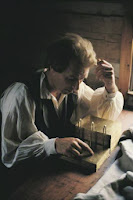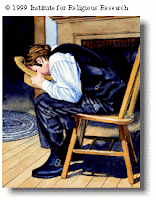The most recent one concerns how Joseph Smith translated the Book of Mormon. What is depicted in the church’s art usually involved Joseph Smith looking at a set of golden plates with Oliver Cowdery acting as a scribe. Here are a bunch of examples:
One thing to note is that with only one exception, none of them show him using the “Nephite Interpreters,” commonly known as the Urim & Thummim, and most do not show a curtain separating Joseph and Oliver.
But after years of denying it, the church finally admits that it was translated by use of a seer stone in Joseph Smith’s hat. These pictures are probably more accurate:
What’s interesting about these is that one of them came from the show South Park. They had a better description of the translation process than the LDS church did!
Here are some supporting statements from LDS church history corroborating this:
Emma Smith (Joseph's first wife):
"In writing for your father I frequently wrote day after day, often sitting at the table close by him, he sitting with his face buried in his hat, with the stone in it, and dictating hour after hour with nothing between us."
- The Saints Herald, Vol. 26, No. 19, p.289
David Whitmer (one of the Three Witnesses of the Book of Mormon):
"I will now give you a description of the manner in which the Book of Mormon was translated. Joseph Smith would put the seer stone into a hat, and put his face in the hat, drawing it closely around his face to exclude the light; and in the darkness the spiritual light would shine. A piece of something resembling parchment would appear, and on that appeared the writing. One character at a time would appear, and under it was the interpretation in English. Brother Joseph would read off the English to Oliver Cowdery, who was his principal scribe, and when it was written down and repeated to Brother Joseph to see if it was correct, then it would disappear, and another character with the interpretation would appear. Thus the Book of Mormon was translated by the gift and power of God, and not by any power of man."
To be fair, Apostle Russell Nelson did use that quote in an Ensign article in July of 1993. But until now, that statement had only been in print once during my entire life. It does seem like the church wasn't too keen on being forthright about this.
Here are statements from past General Authorities about the “seer stone” method of translation:
Joseph Fielding Smith, 10th president of the church:
While the statement has been made by some writers that the Prophet JS used a seerstone part of the time in his translating of the record, and information points to the fact that he did have in his possession such a stone, yet there is no authentic statement in the history of the church which states that the use of such a stone was made in that translation. The information is all hearsay, and personally, I do not believe that the stone was used for this purpose.
...
It hardly seems reasonable to suppose that the prophet would substitute something evidently inferior [to the Urim & Thummim] under these circumstances. It may have been so, but it is so easy for a story of this kind to be circulated due to the fact that the prophet did possess a seerstone, which he may have used for some other purposes.
- Doctrines of Salvation vol.3 pg 225-226
Apostle Bruce R. McConkie:
"In imitation of the true order of heaven where seers receive revelation from God through the Urim & Thummim, the devil gives revelations to some of his followers through peepstones or crystal balls."
- in his book Mormon Doctrine under peepstones
Improvement Era Article:
"In the opinion of the writer, the Prophet used no seer stone in translating the Book of Mormon, neither did he translate in the manner described by David Whitmer and Martin Harris. The statements of both of these men are to be explained by the eagerness of old age to call upon a fading and uncertain memory for the details of events which still remained real and objective to them."
Improvement Era, October, 1939
Apostle John A. Widtsoe:
"Some use was made also of the seer stone and occasional mention was made of it. This was a stone found while the Prophet assisted in digging a well for Clark Chase. By divine power this stone was made serviceable to Joseph Smith in the early part of his ministry. There is no evidence that this stone was used in Joseph's sacred work"
- Joseph Smith—Seeker After Truth, 1951, p. 267
And here’s the best part: they still have the stone in the Church’s vaults.
Joseph Fielding Smith, the tenth President of the LDS church:
"The statement has been made that the Urim and Thummim was on the altar in the Manti Temple when that building was dedicated. The Urim and Thummim so spoken of, however, was the seer stone which was in the possession of the Prophet Joseph Smith in early days. This seer stone is now in the possession of the church."
- (Doctrines of Salvation,Vol. 3, p. 225)
Why wouldn’t they want to parade this out and show people? Because it seems weird, hokey, and makes it look more like “folk magic” rather than divine inspiration. Add to that the fact that Joseph wasn’t even looking at plates at all, and it makes one wonder why it was so important that they were preserved! And if they still have this miraculous stone, why haven't any of the subsequent prophets, seers, and revelators used it to translate?
More information: http://mormonthink.com/transbomweb.htm#introduction
(Written by Joseph)













No comments:
Post a Comment